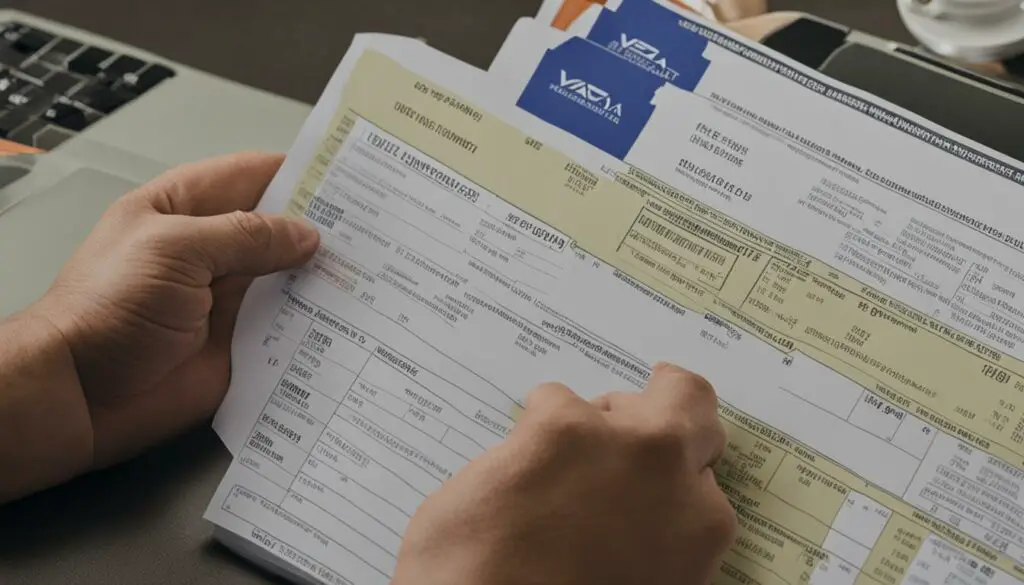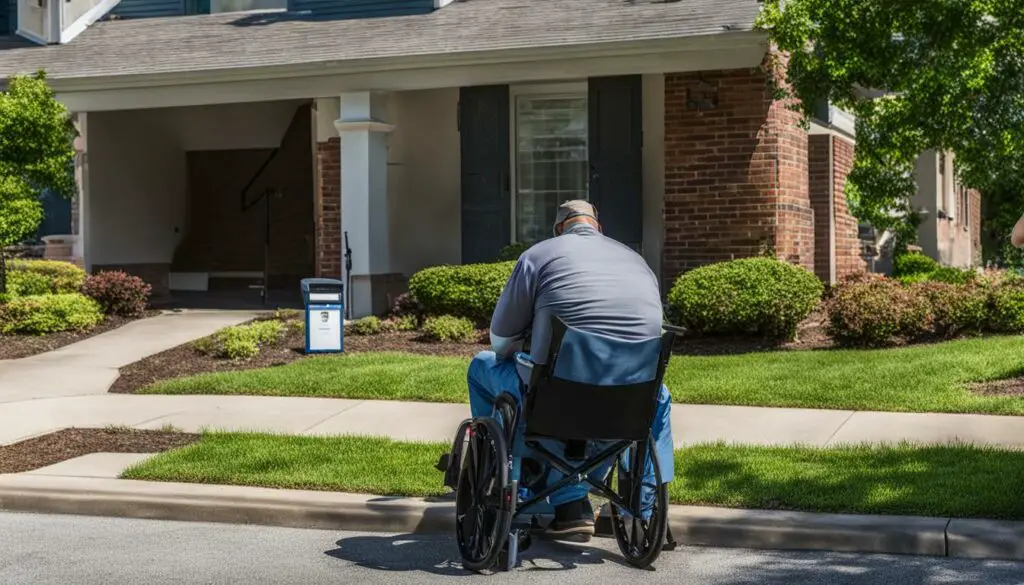Originally posted on December 13, 2023 @ 8:11 pm
If you receive VA disability benefits, you may be wondering if it counts as income for food stamp eligibility. To determine eligibility for food stamps, also known as the Supplemental Nutrition Assistance Program (SNAP), you must meet certain requirements based on income and resources. These SNAP eligibility rules apply to all households, including those with elderly or disabled members.
Table of Contents
Key Takeaways:
- VA disability benefits are counted as income for SNAP purposes.
- To be eligible for SNAP, your household must meet certain income and resource requirements.
- Disabled individuals, including disabled veterans, may be exempt from certain SNAP eligibility requirements.
- Each state has its own SNAP application process, so it’s important to contact your state agency for guidance.
- If approved for SNAP benefits, you will receive an Electronic Benefit Transfer (EBT) card to purchase eligible food items.
Understanding SNAP Eligibility

If you’re wondering, “am I eligible for SNAP?” or “how do I apply for SNAP?” it’s important to understand the household requirements for the Supplemental Nutrition Assistance Program (SNAP). SNAP benefits are administered by state agencies, and each state has its own application process.
To determine your eligibility for SNAP, you must submit an application through your state SNAP agency or local office. The eligibility determination is based on several factors, including:
- Income
- Resources
- Household size
It is crucial to contact your state agency directly to apply and receive information about the status of your application. Applying for SNAP benefits can help ensure that you and your household have access to the food and nutrition support you need.
Snap Eligibility for Disabled Individuals

When it comes to SNAP eligibility, individuals are considered disabled if they meet certain criteria. This includes:
- Receiving federal disability or blindness payments under the Social Security Act
- Receiving state disability or blindness payments based on SSI rules
- Receiving a disability retirement benefit from a governmental agency
- Receiving an annuity under the Railroad Retirement Act and being eligible for Medicare
- Being a veteran who is totally disabled, permanently homebound, or in need of regular aid and attendance
- Being a surviving spouse or child of a veteran receiving VA benefits and considered permanently disabled
Disabled individuals, including disabled veterans, may be exempt from certain SNAP eligibility requirements. This means that they may not have to meet the same income and resource limits as other SNAP applicants. It’s important for disabled individuals and their families to understand these exemptions and how they can affect SNAP eligibility.
Exemptions for Disabled Individuals
In SNAP, there are certain exemptions for disabled individuals, including disabled veterans. These exemptions may vary by state, so it’s important to consult with your local SNAP office for specific details. However, some common exemptions include:
- Exemption from the gross income limit
- Exemption from certain asset or resource limits
- Exemption from work requirements
These exemptions are designed to ensure that disabled individuals have access to the food assistance they need, regardless of their income or resources.
Snap Income Limits and VA Disability

Snap, also known as the Supplemental Nutrition Assistance Program, has specific income limits that households must meet in order to be eligible for benefits. These income limits vary based on the size of the household and are updated annually. For most households, both a gross income limit and a net income limit must be met. However, households with a disabled individual or someone aged 60 or older only need to meet the net income limit.
When determining Snap eligibility, all income is counted unless explicitly excluded. This means that VA disability benefits, which are a form of income, are counted towards the income limits for Snap. If you receive VA disability benefits, they will be considered as part of your household income when determining your eligibility for Snap benefits.
It’s important to note that there are specific guidelines and calculations used by the Snap program to determine how much of your VA disability benefits are counted towards your income. The specific details can vary based on your state and individual circumstances.
For more information on how Snap income limits are calculated and how VA disability affects Snap eligibility, it is recommended to contact your state Snap agency or local office. They will be able to provide you with personalized guidance and assistance based on your specific situation.
SNAP Resources and VA Disability

When determining eligibility for SNAP benefits, households must not only meet income requirements but also adhere to resource limits. Countable resources, such as cash or money in a bank account, are subject to these limits. The resource limits differ based on household composition and whether there is a disabled individual or someone aged 60 or older in the household.
However, it’s important to note that certain resources are excluded from the calculation of SNAP eligibility. Examples of resources that are typically not counted include a primary home and lot, resources of individuals receiving Supplemental Security Income (SSI), Temporary Assistance for Needy Families (TANF), and most retirement and pension plans. Licensed vehicles are generally considered as countable resources, although there are exceptions for specialized types of vehicles.
If we take a closer look at the resource limits, we can gain a better understanding of how VA disability affects SNAP eligibility. Let’s explore this in the table below:
| Household Composition | SNAP Resource Limit |
|---|---|
| Households without a Disabled Individual or Individuals Aged 60 or Older | $2,250 |
| Households with a Disabled Individual or Individual Aged 60 or Older | $3,500 |
Note: These resource limits are subject to change and may vary based on individual circumstances.
The table above shows the SNAP resource limits for households with and without a disabled individual or someone aged 60 or older. It is worth mentioning that these resource limits apply to countable resources only and do not include exempt resources like the home and lot or retirement plans.
By understanding the SNAP resource limits and how VA disability interacts with these limits, households can navigate the eligibility criteria more effectively and determine their eligibility for SNAP benefits.
Applying for SNAP Benefits

Applying for SNAP benefits is a straightforward process that begins with contacting your state SNAP agency or local office. Each state has its own application form and process, which can typically be completed online, in person, or over the phone. To ensure a smooth application process, it’s essential to gather all the necessary documentation and information beforehand.
Here are the steps to apply for SNAP benefits:
- Contact your state SNAP agency or local office.
- Inquire about the application process and ask any questions you may have.
- Obtain the required application form.
- Complete the application form accurately and thoroughly.
- Submit the application form through the designated method (online, in person, or over the phone).
- Provide any additional documentation or information as requested.
If you need assistance or have questions about the SNAP application process, don’t hesitate to reach out to your state agency directly. They can provide guidance and support to ensure your application is submitted correctly.
Remember, the application process may vary slightly depending on your state, so it’s crucial to follow the instructions provided by your state SNAP agency or local office.
Receiving SNAP Benefits

If your SNAP application is approved, you will receive benefits on an Electronic Benefit Transfer (EBT) card. This card functions like a debit card and is automatically loaded with your monthly benefits. You can use the EBT card to purchase eligible food items at authorized retailers, including grocery stores and farmers’ markets.
It is important to keep track of your SNAP benefits and use them wisely within the specified time period.
Here is a list of steps to help you receive SNAP benefits:
- Submit your SNAP application and provide all necessary documentation.
- Wait for your application to be processed and approved.
- Upon approval, you will receive your EBT card in the mail.
- Activate your EBT card according to the instructions provided.
- Start using your EBT card at authorized retailers to purchase eligible food items.
Remember, you can only use your EBT card at authorized retailers. These include grocery stores, supermarkets, and farmers’ markets. Make sure to check for the SNAP logo or signage at the store to ensure they accept EBT cards.
Using your EBT card responsibly and within the designated time period will help you make the most of your SNAP benefits and ensure you have access to nutritious food.
Snap Certification Period and Recertification

If you are eligible for SNAP benefits, you will receive a notice that specifies the length of your certification period. This is the duration during which you will receive SNAP benefits. It is essential to know the duration of your certification period to plan accordingly.
Before the certification period ends, you will receive another notice informing you of the recertification process. During recertification, you must update your information to ensure that your eligibility for SNAP benefits is maintained. It is vital to recertify promptly to avoid any disruption in your benefits.
To recertify for SNAP benefits, contact your local SNAP office or visit their website for information on the recertification process. They will provide you with the necessary forms and instructions on how to complete them.
Make sure to have the required documentation ready for recertification. This may include proof of income, rent or mortgage payments, utility bills, and any changes in your household size or circumstances.
By recertifying your eligibility for SNAP benefits, you ensure that you continue to receive the support you need to meet your nutritional needs.
Snap Certification Period and Recertification Process Summary:
| SNAP Certification Period | Recertification Process |
|---|---|
| The length of time during which you receive SNAP benefits. | An update of your information to maintain eligibility. |
| Receive a notice specifying the duration of your certification period. | Receive a notice prompting you to recertify. |
| Contact your local SNAP office for recertification information. | Gather the required documentation for the recertification process. |
| Plan accordingly based on the duration of your certification period. | Complete the recertification process to ensure continued benefits. |
Recertification is an essential part of the SNAP program to ensure that benefits are provided to those who still meet the eligibility criteria. By staying informed and actively participating in the recertification process, you can continue to receive the assistance you need to access nutritious food for you and your family.
SNAP Exemptions for Disabled Veterans
Disabled veterans receiving VA disability benefits may be eligible for certain exemptions when applying for SNAP benefits. These exemptions can provide valuable assistance to disabled veterans and their families, ensuring they have access to the support they need for their nutritional needs.
If you are a disabled veteran, your VA disability benefits may qualify you as disabled for SNAP purposes. This means that you may be exempt from the gross income limit requirement when determining your SNAP eligibility. Exemptions like these can significantly impact the eligibility criteria for disabled veterans and expand their access to essential food assistance.
To fully benefit from these SNAP exemptions, it is crucial for disabled veterans and their families to explore the available options. Contact your local SNAP office to understand the specific SNAP exemptions for disabled veterans and ensure you are aware of all the eligible benefits and resources.
By taking advantage of these exemptions, disabled veterans can alleviate financial burdens and gain the necessary support to maintain a healthy and balanced diet.
| Eligibility Criteria | Exemptions for Disabled Veterans |
| ——————– | ——————————- |
| Gross Income Limit | Exempt |
Conclusion
In conclusion, VA disability benefits are counted as income for SNAP (Supplemental Nutrition Assistance Program) purposes. When determining eligibility for food stamps, it is crucial to consider various factors such as income, resources, and household size. However, disabled veterans may qualify for exemptions from certain SNAP eligibility requirements.
It is essential for disabled veterans and their families to familiarize themselves with the eligibility criteria and the application process for SNAP benefits. To receive personalized guidance and assistance, it is recommended to contact the state SNAP agency or local office directly. They can provide valuable information and support throughout the application process.
Understanding the relationship between VA disability and food stamps can significantly impact the overall financial well-being and nutrition of disabled veterans and their families. By taking advantage of the available resources and exemptions, disabled veterans can ensure they receive the assistance they need to meet their food-related expenses.
FAQ
Does VA disability count as income for food stamps?
Yes, VA disability benefits are considered income for food stamp eligibility.
What are the eligibility requirements for SNAP (food stamps)?
To be eligible for SNAP benefits, you must meet certain requirements based on income, resources, and household size. Each state has its own application process.
Who is considered disabled for SNAP purposes?
Disabled individuals for SNAP purposes include those receiving federal disability or blindness payments, state disability or blindness payments based on SSI rules, disability retirement benefits, annuities under the Railroad Retirement Act and eligibility for Medicare, and veterans who are totally disabled, permanently homebound, or in need of regular aid and attendance. Surviving spouses or children of veterans receiving VA benefits and considered permanently disabled are also eligible.
How does VA disability affect SNAP eligibility?
VA disability benefits are counted as income for SNAP purposes. Disabled veterans and their families may qualify for exemptions from certain SNAP eligibility requirements.
What are the income limits for SNAP?
SNAP has both a gross income limit and a net income limit. Disabled individuals or households with someone aged 60 or older only need to meet the net income limit. The specific income limits vary by household size and are updated annually.
Are VA disability benefits counted as income for SNAP?
Yes, VA disability benefits are counted as income for SNAP purposes.
How do I apply for SNAP benefits?
To apply for SNAP benefits, you must contact your state SNAP agency or local office. Each state has its own application form and process, which can usually be completed online, in person, or over the phone.
How do I receive SNAP benefits?
If your SNAP application is approved, you will receive benefits on an Electronic Benefit Transfer (EBT) card. This card can be used to purchase eligible food items at authorized retailers, including grocery stores and farmers’ markets.
What is the SNAP certification period?
The SNAP certification period is the duration during which you will receive SNAP benefits. Before the certification period ends, you will receive information about the recertification process.
Are there exemptions for disabled veterans in SNAP?
Yes, disabled veterans may be exempt from certain SNAP eligibility requirements. It is important for disabled veterans and their families to contact their local SNAP office to ensure they are aware of all eligible benefits and resources.
What should I do if I have VA disability and need assistance with SNAP?
If you have VA disability and need assistance with SNAP, you should contact your state SNAP agency or local office for personalized guidance and assistance.
Source Links
- https://www.fns.usda.gov/snap/eligibility/elderly-disabled-special-rules
- https://www.statesidelegal.org/how-get-food-supplements-disabled-veterans
- https://www.usda.gov/media/blog/2013/02/27/snap-remains-safety-net-veterans-and-families-need
See also:
Leave a Reply